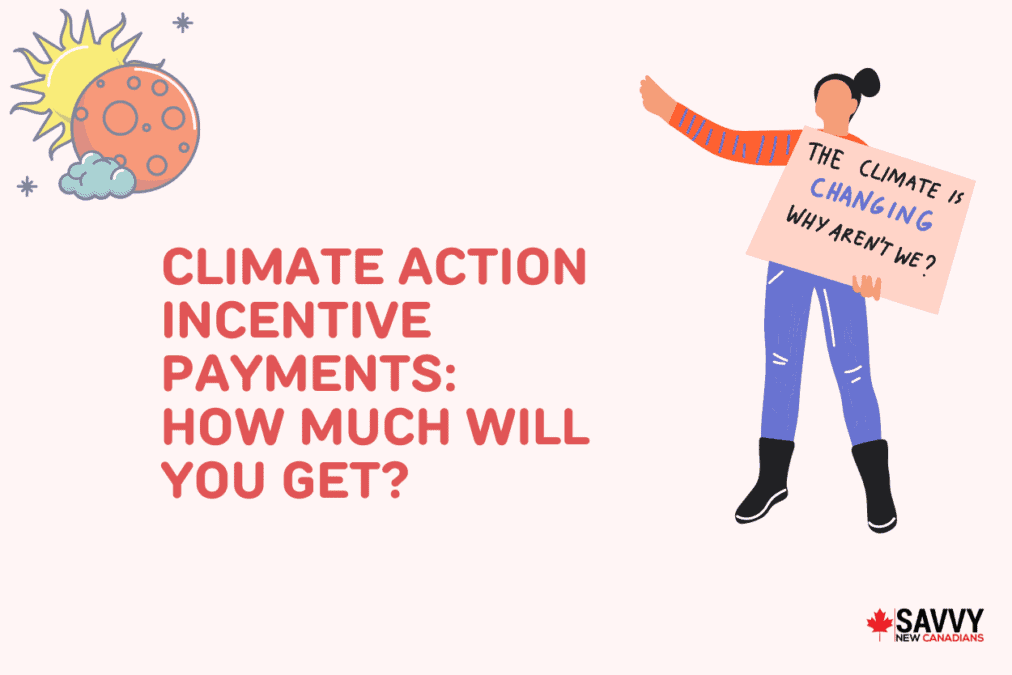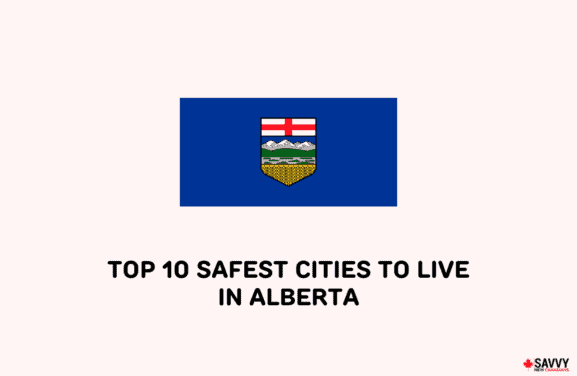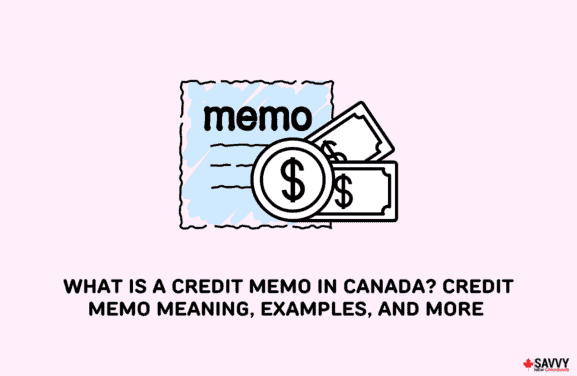Quick Answer
- The quarterly CAIP payments are paid on the 15th of January, April, July, and October. When the 15th falls on a weekend or a holiday, payments are made on the nearest previous business day.
- Residents of Newfoundland and Labrador, Nova Scotia, and Prince Endward Island started receiving CAIP payments from July 2023 onwards.
- Canadian residents don’t need to apply for the CAIP. You’ll automatically be eligible if your income tax and benefit return meets all the required criteria.
The Climate Action Incentive Payment (CAIP) is a tax-free quarterly benefit for Canadian residents living in Alberta, Manitoba, Ontario, or Saskatchewan.
Previously, it was a refundable tax credit you could claim on your income tax return. Now, it is a payment made directly to your bank each quarter.
This guide will tell you everything you need to know about the Climate Action Incentive Payment, including who is eligible, how to apply, the payment dates, and more.
Climate Action Incentive Payment (CAIP) Amounts in 2023-2024
The Climate Action Incentive Payments increase slightly each year but are not relative to your income.
Below is a breakdown of how much you can receive in total for the 2023-2024 payment period, depending on which province you live in.
Quarterly Climate Action Incentive Payment Amounts
These incentive payment amounts will be paid on January 15, April 15, July 15, and October 15th in 2024. For residents of Newfoundland and Labrador, Nova Scotia, and Prince Edward Island, payments commenced in July 2023.
| AB | MB | ON | SK | NL | NS | PEI* | |
| First Adult | $193 | $132 | $122 | $170 | $164 | $124 | $120 |
| Second Adult | $96.50 | $66 | $61 | $85 | $82 | $62 | $60 |
| Each Child | $48.25 | $33 | $30.50 | $42.50 | $41 | $31 | $30 |
| Family of 4 | $386 | $264 | $244 | $340 | $328 | $248 | $240 |
Note 1: The PEI quarterly payments include the 10% rural supplement that all residents are eligible for. Other province’s rural residents will receive an additional 10% rural supplement on top of the mentioned amounts.
Note 2: New Brunswick’s October payment is a double payment, as it also includes the July payment.
Below is a comparison of the Climate Action Incentive amounts that provinces have received over the previous three years.
Climate Action Incentive Payments in Alberta
| 2021 | 2022 | 2023 | |
| First Adult | $486 | $539 | $772 |
| Spouse/Common-law Partner | $248 | $270 | $386 |
| Dependent Child | $124 | $135 | $193 |
| Family of 4 | $992 | $1,079 | $1,544 |
Related: Alberta Minimum Wage.
Climate Action Incentive Payments in Ontario
| 2021 | 2022 | 2023 | |
| First Adult | $295 | $373 | $488 |
| Spouse/Common-law Partner | $147 | $186 | $244 |
| Dependent Child | $73 | $93 | $122 |
| Family of 4 | $588 | $745 | $976 |
Related: Ontario Minimum Wage.
Climate Action Incentive Payments in Manitoba
| 2021 | 2022 | 2023 | |
| First Adult | $328 | $416 | $528 |
| Spouse/Common-law Partner | $164 | $208 | $264 |
| Dependent Child | $81 | $104 | $132 |
| Family of 4 | $654 | $832 | $1,056 |
Related: Manitoba Minimum Wage.
Climate Action Incentive Payments in Saskatchewan
| 2021 | 2022 | 2023 | |
| First Adult | $596 | $550 | $680 |
| Spouse/Common-law Partner | $297 | $275 | $340 |
| Dependent Child | $148 | $138 | $170 |
| Family of 4 | $1,189 | $1,101 | $1,360 |
Related: Saskatchewan Income Tax Brackets and Rates.
Climate Action Incentive Payment Explained
The Climate Action Incentive Payment (CAIP) is a tax-free monetary amount paid to help Canadian residents counter the cost of the pricing for federal pollution.
It is a basic amount plus a supplement for residents of rural and small communities.
The CAIP is offered as a tax-free benefit on a quarterly basis to residents of Ontario, Saskatchewan, Alberta, and Manitoba. As of July 2023, it has expanded its availability to include PEI, NL, and NS residents.
Before 2021, it was known as the Climate Action Incentive (CAI), a refundable tax credit you could claim on your annual personal income tax return.
Eligibility for the Climate Action Incentive Payment
You are only eligible for the Climate Action Incentive Payment if, on the first day of the payment month and the last day of the previous month, you are a resident of the following provinces:
- Ontario
- Manitoba
- Saskatchewan
- Alberta
- Newfoundland and Labrador
- Nova Scotia
- Prince Endward Island
You must also be 19 years or older OR have (or previously had) a common-law partner or spouse, OR are (or previously were) a parent and live with your child.
Who is not Eligible for the Climate Action Incentive Payment?
If you are NOT a resident of an applicable CAIP province mentioned above, you’re not eligible for the CAIP payments. However, other provinces have carbon tax rebates (discussed below).
As with any other Canadian tax credits, you will also not be eligible if you:
- Were a non-resident of Canada at any time during the tax year
- Confined to a prison or similar institution for at least 90 days during the tax year
- Are exempt due to being a servant or officer for the government
Climate Action Incentive Payment Dates in 2024
Climate Action Incentive Payments are paid every quarter. CAIP payment dates in 2024 are as follows:
- January 15, 2024
- April 15, 2024
- July 15, 2024
- October 15, 2024

How To Apply for the Climate Action Incentive Payment (CAIP)
Residents of Canada:
You do not need to apply for the CAIP. If you are eligible when you file your income tax and benefit return, the Canada Revenue Agency will send the payments throughout the year.
If you have a common-law partner or spouse, only one person will be eligible for the Climate Action Incentive Payments. This credit will be sent to the person whose tax return is submitted first.
If you are a resident of a rural or small community, you may be eligible for a supplement. To apply, you must complete Schedule 14 and send it with your income tax return. To see if you are eligible for the supplement, check here.
Newcomers to Canada:
If you are new to Canada, you will need to fill out one of two forms to apply for the CAIP:
1. For those who do NOT have children: Form RC151, GST/HST and CAI Credit Application for Individuals Who Become Residents of Canada.
2. For those who DO have children: Form RC66, Canada Child Benefits Application to apply for all family and child benefits. You must also fill out Form RC66SCH, Status in Canada and Income Information for the Canada Child Benefits Application.
After the forms are complete, mail them to your tax centre.
Carbon Tax Rebates in Canada (Federal vs Provincial)
Each province in Canada has chosen either the federal pricing system or designed its own pricing system for carbon tax rebates.
Below is a summary of the carbon tax rebate system for each province that does not participate in the CAIP.
British Columbia’s emissions are covered by the carbon tax for the province. BC has an annual climate action tax credit (BCCATC), a tax-free payment to families and individuals with a low income to help counteract the carbon taxes they pay.
Quebec has a cap-and-trade system where they set caps on emissions by industry. Companies that cannot reduce emissions below that cap must buy credits from a carbon market. There is no federal rebate.
New Brunswick has a system to allow for higher pollution thresholds while maintaining their price per tonne standards. They get CAI payments.
Northwest Territories has its own territorial carbon tax, implemented in 2019. They charge $40 per tonne and have a 100% rebate on home heating fuel.
Yukon and Nunavut are a part of the federal carbon tax plan. Yukon has rebates, while Nunavut does not.
CAIP FAQs
You will receive the Climate Action Incentive payments on January 15, 2024, April 15, 2024, July 15, 2024, and October 15, 2024.
The CAIP includes a 10% supplement for residents of rural and small communities. This applies to those living in one of the four eligible provinces whose residence is outside a census metropolitan area.
The CAIP in 2023 varies by province, depending on whether you are a single person, a second adult, a dependent child, or a family of four. See above for the Climate Action Incentive Payments tables.
If you are a resident of Alberta, Ontario, Manitoba, or Saskatchewan, you should claim the CAIP on your tax return. All you need to do is fill out Schedule 14, which is part of your tax return. The CRA will automatically determine if you are eligible.
The Climate Action Incentive is paid directly to your bank as a quarterly benefit.





hi is there a phone# for info on caip?
thank you
So if everyone gets the same, why did we (my husband and I ) get $307.45 and $113.99 which is $421.54. $137.46 less than expected. Thank you
@Jeannine: The amount depends on your province and it is also split into 4 quarters, with the July payment also including what should have been paid out in April.
I DO NOT HAVE DIRECT DEPOSIT WILL IT BE MAILED TO ME
@Walter: Yes, you should receive a cheque by mail.
Why only receive $404.50 and my wife Flora Candeias dont receive anything
@Fernado: The CAIP credit is paid to the spouse or common-law partner whose tax return is assessed first. So, what you received is a combination of your benefits as a family.
why I didn’t received the CAIP?
I received the CAIP cheque and was wondering if it is a taxable benefit? Can it be claimed by the lower income earner rather than the person the cheque was made out to?
@Doug: The CAIP is a tax-free benefit.
I received a notice from Canada Revenue stating a deposit of the CAIP was deposited on July 15, 2022. It is not there. Who can I cpntact about this?
@S. Matthews: The phone number I could find for CAIP is 1-800-387-1193. As per their website, you should allow up to 10 business days after the expected payment date before calling.
I called the number and listened to it all and then pushed 0. About 10 minutes on hold and it was fixed!
Scott I’m really starting to think that the government lies about payments that being the chunk of money we’re supposed to get what’s this 135.00 in my bank that’s not nearly enough for myself it’s ridiculous good job Trudeau or whoever’s doing this !!!??
If you aren’t eligible for child tax benefit (income too high) you will not receive this for your children. So it is in fact income based.
If mailed when will I receive the cheque for Carbon taxes???
@Kayla: I am not sure, as the website doesn’t appear to have this information.
hello,,,will I still get the CAIP check if I am renting and not paying any heat or utilities? I amon ODSP and OAS and I make about $1722 a month and my rent will be going up from $938 to about another $25
What happens if you are in bankruptcy? Every single thing the government is giving to low income or in general is going to c/o Trustee. So I get nothing?
i have recieved only one payment during this plan. july 2023, none before or since.
Hi, My husband and I are in Northern Ontario in a rural environment. He is 80 and myself 69 we had the payments last year but have received nothing this January. Can you tell me please why we didn’t receive the payment?
@Dawn: Difficult to say since it is not tied to your income. It would be best to give them a call to confirm: 1-800-959-8281
If we are Temporary resident and arrived to Canada last June 30, 2023, are we still eligible for this benefit?